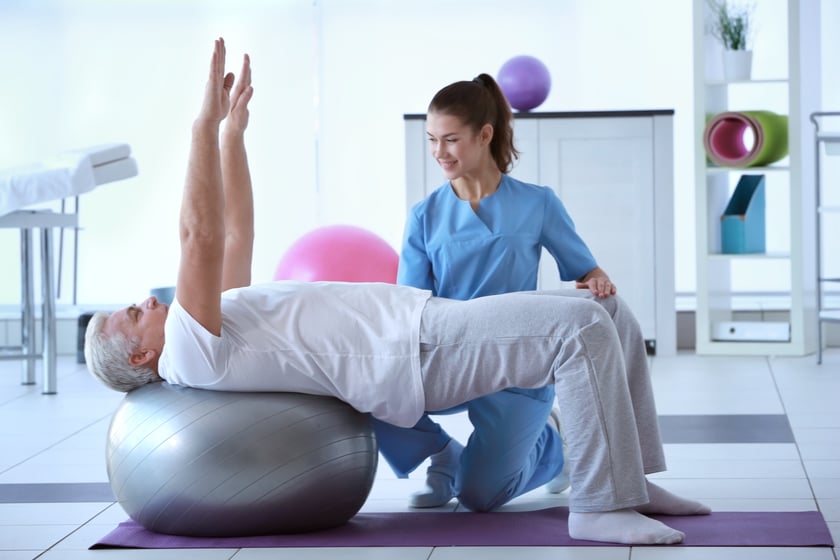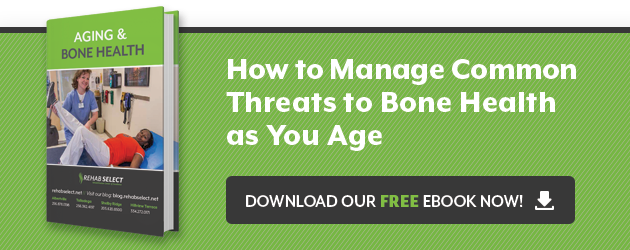
Osteoporosis is a condition that results in weakening bones, but osteoporosis rehabilitation gives you the proactive power to counteract the condition. Osteoporosis rehabilitation typically consists of orthopedic rehab, physical therapy, occupational therapy, nutrition counseling, and various other personalized treatments to help you tackle your condition and improve the quality of your life.
Each of these therapies provide synergistic benefits, meaning they build off of each other, especially with early, rigorous implementation. For example, when you eat bone- and muscle-building foods, perform weight-bearing exercises, and take the right supplements at the same time, you should see more significant results than if you tried all of these approaches sporadically.
Early intervention, including a comprehensive rehabilitation program, provides many benefits for people with osteoporosis.
Benefits of Rehabilitation for Osteoporosis
1. Increased bone density
Weight-bearing activity along with calcium and vitamin D supplementation can strengthen your bones and minimize bone loss. Weight-bearing activities include exercises you perform on your feet that support your full body weight, such as brisk walking, jogging, or dancing. The forces of gravity and your weight on your skeletal system encourage the bone rebuilding process.
Low-intensity versions of these exercises are typically recommended for those at a high risk of fracture. There’s a specific threshold of exercise that helps maintain your bone structure. Too little weight-bearing activity and your body will continue to lose bone mass, while too much strain can cause pain or fracture risk. Your therapist designs a program within a safe window that’s most beneficial for your bone health.
Your doctor and nutritionist can also help you make dietary changes to support bone health. They help ensure you get enough vitamin D, calcium, and other beneficial minerals from the food you eat or supplements. Exercise and proper nutrient intake are two of the most effective ways to increase bone mass for people with osteoporosis.
2. Reduced risk of falls
Osteoporosis rehabilitation exercises focus not only on improving your mobility and weight-bearing capacity, but they also emphasize fall prevention. Training that includes stability exercises and mechanical and posture training, for example, helps you maintain balance during your everyday activities, which helps minimize your risk of fracture. Fractures are one of the significant dangers people with osteoporosis face, so it’s important to address fall prevention with individualized programming.
Patient education, home modifications, and assistive devices also have a positive effect on your ability to achieve balance. Aids such as a cane or shower railings help you avoid falls where you might be prone to slip. Your rehab specialists provide you with the most effective tools to prevent falls and fall-related injuries.
3. Reduced incidence of disability
Your body’s inability to maintain adequate bone density means you’re at a higher risk for fractures and other complications of osteoporosis. A hip or spine fracture, for example, can limit your mobility and potentially cause permanent disability. The debilitating effects of a fracture may mean you can’t work or participate in activities you enjoy and need to rely more heavily on family or caretakers for help.
To avoid disability, your rehabilitation protocol is meant to slow or stop the progression of osteoporosis, decrease pain, and reduce the risk of fracture. In other words, rehab helps you maintain your normal routine and avoid the devastating effects of a disability.
4. Improved strength and movement
Therapeutic exercises are an effective way to prevent and treat osteoporosis. In addition to weight-bearing activity, strengthening exercises with weights, resistance bands, and body weight have many benefits for muscle and bone health. You can expect your osteoporosis treatment plan to include resistance training.
Resistance training increases your physical conditioning and mobility. Working your muscles also contributes to your balance, coordination, and fracture prevention. For example, research shows the strength of your back is directly related to a decreased risk of spinal fracture and back pain, and leg muscles help you stand strong and avoid hip and lower extremity fractures.
Benefits of Inpatient vs. Outpatient Rehabilitation for Osteoporosis
If your doctor recommends a rehabilitation program for osteoporosis, you face some decisions about the facility you choose for treatment. Your choice often depends on location, insurance coverage, and your personal preferences.
The different types of inpatient and outpatient rehabilitation have advantages and disadvantages that may influence your choice. Take a look at the benefits of each.
Inpatient rehabilitation
Inpatient rehabilitation may be a good choice if you have a severe, advanced case of osteoporosis. If you’re immobilized, recovering from surgery, face a long recovery, or experience severe complications, an inpatient setting may benefit you.
An inpatient setting usually gives you 24-hour access to medical care and a multidisciplinary medical team. You spend the majority of your day attending different therapy sessions to help you make continual progress, and there’s always a medical professional available for questions or care.
All your needs are taken care of in an inpatient facility as well, including meals, social opportunities, laundry, and cleaning services. That way, you’re able to give full focus to your recuperation and don’t have to rely on outside assistance.
Outpatient rehabilitation
Outpatient rehabilitation is usually preferred by those who wish to maintain normalcy in their daily routines and are in a highly functional stage of osteoporosis. You may be able to schedule your appointments around your agenda. You also get to return home after your appointments and maintain your independence.
If you have few functional limitations, you’ll still benefit greatly from therapy but not require as much rigorous, around-the-clock care. You may only have to dedicate from one to several hours to your appointments, depending on your needs.
Your choice of inpatient versus outpatient therapy depends on many factors, especially the severity of your condition. It’s important to discuss osteoporosis rehabilitation with your medical team, insurance provider, and loved ones to find the option that works for you.
Rehab Select provides both inpatient and outpatient rehabilitation options for osteoporosis treatment. Our full, multidisciplinary medical team can help you to manage your condition using the most effective, up-to-date approaches. To find out more or schedule a tour, contact Rehab Select today by filling out this brief online form or calling the number listed at the top of this page.





